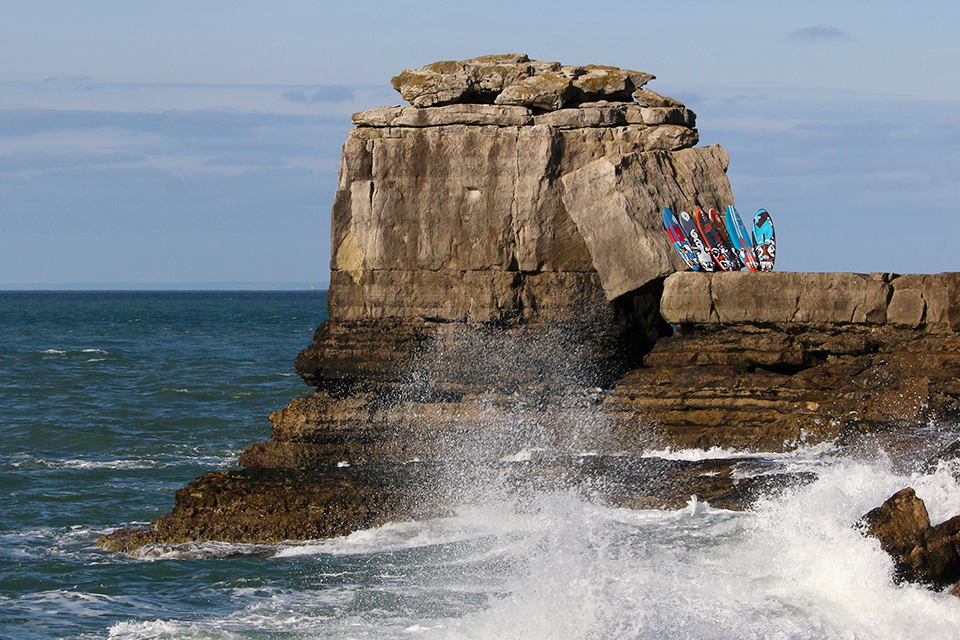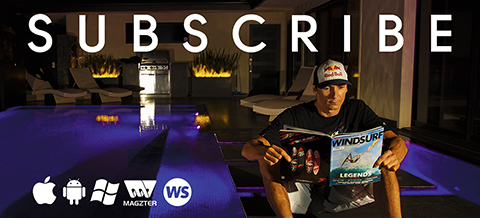THE PILLARS OF SPEED
120L FREERACE BOARD TEST 2016
Test Editor Tris Best // Second Testers Maurin Rottenwalbter, Dan Hallam, Tom Wells & Scott Stallman
Photos Andy Stallman // Test Location OTC, Portland, Dorset
Freerace, as a category, was a pretty clear and obvious progression from freeride back in the day. There was a large void in the market between the user-friendly and practical world of freeride and the all-out guns-blazing fury of World Tour slalom sailing.
This test was originally published in the April 2016 issue.
It was as if they were at different ends of the spectrum, one dealing with mass market hang ups, the other simply looking to be first past the post. Well, it is fair to say that over the years, the distance between these two worlds has narrowed, putting the squeeze on the freerace sector. Many of the modern thin-and-wide style freeride boards are astoundingly quick, lively and exciting to ride whilst retaining their wide base and therefore ease of use. And as for slalom, we only need to look out of our centre window and onto the water in Portland Harbour to see just how many recreational sailors are now using top end production slalom boards. Whilst most if not all brands use their fastest slalom rocker lines as the foundation for their freerace hull, Fanatic have been going the whole hog for the last few years, using exactly the same design in their freerace board as their slalom machine, but refining it with a heavier construction and more footstrap options. So is the need for freerace as a stand-alone discipline diminishing?
When the Royal Yachting Association (RYA) changed their windsurfing tuition model back in 2006, they did so for one straightforward reason. Being windsurfers themselves and understanding the draw to the high wind planing aspect of the sport, they wanted to fast-track people through the levels and into these conditions with the intention of getting them hooked. The sooner people experienced that planing sensation, the more likely they are to remain doing it. And more people in the sport can only be a good thing for everyone. So the RYA employed professional coach Simon Bornhoft and the Fast Forward formula was born. The interesting thing is that the formula focussed on trying to get people doing one thing – blasting. Experience the speed and the adrenaline of the sport and you can’t help but become addicted! It’s an age-old thing – everyone likes to go fast. RRD have said it themselves in their marketing for the new V3 Firestorm tested here; with all the different qualities to consider, they did hours of R&D and made dozens of prototypes to develop a better product. But in the end they stripped it back to focus on one simple quality …speed. Everyone likes to go fast. Full stop. That should be the sole focus. Or should it? Speed can also be unnerving if it can’t be controlled. Think back to your first ever time on a windsurfing board. I wager that when you first maintained your balance long enough to pull in the sail to squeeze the board forward, you felt like you were going a million miles an hour! Is that not blasting? Did that not excite you? The real truth is that speed as an entity is directly related to control. You only really feel you are pushing your speed limit when you are flirting with the edge of your comfort zone, your control envelope. So as such, even if it’s not uttered in the market description and fades into the discipline shadows, the freerace balance of ‘slalom speed tempered with just a hint of freeride control’ will always be in demand.
FINDINGS
As with most iterative design, board development is always a compromise – change one parameter and you’ll have a direct effect on another. So with the slalom rocker line adopted, most brands have looked at other characteristics to improve control, be it refined rail shapes, a narrower tail with reduced tail cutouts, or more inboard footstrap positions. One very interesting development we have seen in a couple of the boards here is the movement of fin box further forward into the board and away from the tail. By doing so, the idea is that the fin is placed under the back foot of the rider giving them greater feel and control of its lift. But however the balance is reached, the feeling of control will feed the rider’s confidence to push to greater speeds.
SUMMARY
Within the six boards on show here, there is a wealth of experiences to be had on that speed-control scale. At one end we have the Tabou and the Goya, both thriving on being ridden on their fins. The Speedster is probably the most technical to sail in the group, but get it right and it rewards with breath-taking speed and eye-sucking cornering. The Bolt is as close as you can get to slalom performance without fully investing; with life, liveliness and acceleration that can’t help but bring a smile to your face. The RRD is a master at making you feel like you’re sailing on the edge of control when actually you’re nowhere near, giving it a fantastically fun and engaging character. Then there’s the JP and Fanatic that excel at opposite ends of the wind and condition spectrum – the JP feeling familiar underfoot, comfortable at covering great distances and ‘bossing it’ in marginal winds. The Hawk on the other hand is supremely controllable in both a straight line and around the corners, which becomes all the more apparent when the conditions become challenging. That leaves the Starboard. At 76cm wide it is the widest here and yet has the most incredible manners over a simply staggering wind range. It has been a pleasure to test these six boards and reaffirms that freerace is alive and kicking more than ever before.
NONE RECOMMENDED?
The eagle eyed amongst you may well have noticed that there are no longer the fabled words ‘well recommended’ on any of the boards or sails on test in this issue. It is for one very simple and honest truth – it is sometimes all a person looks for when skimming over the reports! To date, in our opinion, any of the items on test simply can’t be summed up in that manner any more. Putting it another way, if we were to specify a type of rider style or role succinctly, we could actually recommend all these products in one way or another. So before delving into the individual reviews, take a moment to think about the sort of windsurfing you actually do and conditions you are likely to experience, then match the product to your own niche requirements.
TEST LOCATION
This test was conducted at the Official Test Centre (OTC), on Portland, Dorset. The centre is based within the grounds of the National Sailing Academy that hosted the Olympic sailing classes in 2012. With the best wind stats on the south coast, mirror flat water in prevailing winds and a safe launch area with excellent facilities, it provides the ideal test venue. Much of the kit is still on site, so why not go and try some of it for yourself?
uk.otc-windsurf.com
THE LINE UP
STARBOARD FUTURA CARBON ULTRACORE 124


